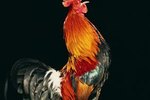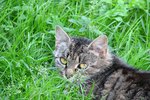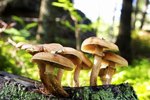
Jasmine, also called jessamine, is a popular, nontoxic, blossoming landscaping plant. It typically bears white flowers and, less often, pink or yellow flowers. However, another jasmine -- known as false jasmine, Carolina jasmine or yellow jasmine -- is indeed a toxic plant. People who keep free-range chickens, particularly backyard suburban flocks, should make themselves aware of what jasmine shrubs and vines look like and how to keep their chickens from being poisoned by them.
Jasmine and Its Properties
True jasmine is a flowering shrub or vine. The shiny, oval leaves are either bunched in groups of three (trifoliate) or are feather-like in shape and arranged on opposite sides of the stem (pinnate). Its waxy-white flowers have five, occasionally six petals. True jasmine plants release their fragrance at night. These flowers are not only prized for their scent, but also for the fragrant oil they possess. The flower of the true jasmine plant can be eaten when grown without pesticides.
The false jasmine plant shares some characteristics with the true jasmine. It also has yellow, five-lobed flowers and shiny green foliage that, unlike true jasmine, are often a funnel-shaped. However, all parts of the false jasmine are highly poisonous from flowers to rhizome (root). The deadly qualities of the false jasmine are similar to the hemlock plant. It's so deadly that bees pollinating the flowers are sometimes poisoned.
How Yellow (False) Jasmine Affects Chickens
A chicken that eats any portion of this plant will experience any number of symptoms. False jasmine contains alkaloids related to strychnine. These alkaloids depress the nervous system, causing paralysis and even death. Death is often caused by paralysis of the chicken’s muscles that control its breathing.
Where Jasmine is Found
True jasmine is native to temperate, warm or tropical areas of the world. It's commonly used in residential landscaping and as decorative inside plants. The false jasmine, however, is native to the United States, so unlike true jasmine it can be found growing wild outside of residential areas. It grows wild along the eastern seaboard from Virginia to Florida and as far west as Mexico. People with backyard chickens in these areas should look for and remove these climbing vines, particularly if they have wooded lots with plenty of moist soil.
Restricting Chickens’ Access to Jasmine

Theoretically, chickens will avoid eating plants that are not good for them. Toxic plants, particularly those with alkaloid toxins, tend to have an unappetizing taste. Because chickens don't like the taste, they will spit out the plant and avoid it on future occasions. However, extremely hungry chickens will forage on whatever is available to them. One way to prevent chickens from eating false jasmine -- or any plant not good for them -- is to keep them well fed. If you have landscaped using a large number of false jasmine plants, you may also consider using decorative fencing that restricts your chickens’ access to them. Carefully dispose of all cuttings in garbage receptacles far from your chickens’ enclosures, as well.
References
- Gifting Inc.: The Flower Expert Guide on Flowers and Gardening: Jasmine
- herbs2000.com: Yellow Jessamine
- Storey’s Guide to Raising Chickens, 3rd Edition
Photo Credits
-
Visage/Stockbyte/Getty Images




